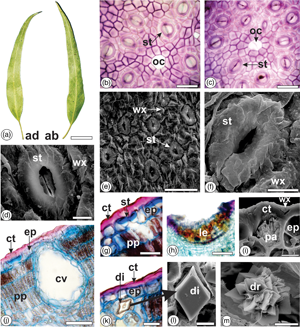Crossref Citations
This article has been cited by the following publications. This list is generated based on data provided by
Crossref.
Manfron, Jane
Farago, Paulo Vitor
Khan, Ikhlas Ahmed
and
Raman, Vijayasankar
2021.
Baccharis.
p.
217.
Nazari Formagio, Anelise Samara
Vilegas, Wagner
Ferreira Volobuff, Carla Roberta
Leite Kassuya, Candida Aparecida
Paes de Almeida, Valter
Manfron, Jane
Pereira, Zefa Valdevina
Pereira Cabral, Marcia Regina
and
Sarragiotto, Maria Helena
2022.
Palicourea tomentosa (Aubl.) Borhidi: Microscopy, chemical composition and the analgesic, anti-inflammatory and anti-acetylcholinesterase potential.
Journal of Ethnopharmacology,
Vol. 291,
Issue. ,
p.
115050.
Malaspina, Paola
Papaianni, Marina
Ranesi, Marta
Polito, Flavio
Danna, Cristina
Aicardi, Pierluca
Cornara, Laura
Woo, Sheridan L.
and
De Feo, Vincenzo
2022.
Eucalyptus cinerea and E. nicholii by-Products as Source of Bioactive Compounds for Agricultural Applications.
Plants,
Vol. 11,
Issue. 20,
p.
2777.
Gribner, Caroline
Barbosa, Vanessa
Monteiro, Luciane Mendes
Swiech, Juliane Nadal Dias
Raman, Vijayasankar
Manfron, Jane
Miguel, Obdulio Gomes
Montrucchio, Deise Prehs
and
de Fátima Gaspari Dias, Josiane
2022.
Microscopic investigations of Ocotea paranaensis―A Brazilian endemic and endangered species.
Microscopy Research and Technique,
Vol. 85,
Issue. 10,
p.
3316.
Raeski, Paola Aparecida
Heiden, Gustavo
Novatski, Andressa
Raman, Vijayasankar
Khan, Ikhlas Ahmed
and
Manfron, Jane
2023.
Calcium oxalate crystal macropattern and its usefulness in the taxonomy of Baccharis (Asteraceae).
Microscopy Research and Technique,
Vol. 86,
Issue. 7,
p.
862.
Antunes, Kevin Alves
Monteiro, Luciane Mendes
Almeida, Valter Paes de
Baldiserra, Luan Junior
Raman, Vijayasankar
and
Manfron, Jane
2023.
Comparative Anatomy of Ilex paraguariensis "Erva-Mate" and its Adulterant Citronella gongonha "Falso-Mate”.
Brazilian Archives of Biology and Technology,
Vol. 66,
Issue. spe,
Raeski, Paola Aparecida
Ayres, Gabrielly de Oliveira
Monteiro, Luciane Mendes
Heiden, Gustavo
Novatski, Andressa
Raman, Vijayasankar
Khan, Ikhlas Ahmed
Lourenço, Emerson Luiz Botelho
Gasparotto Junior, Arquimedes
Farago, Paulo Vitor
and
Manfron, Jane
2023.
Applications of Calcium Oxalate Crystal Microscopy in the Characterization of Baccharis articulata.
Brazilian Archives of Biology and Technology,
Vol. 66,
Issue. spe,
Antunes, Kevin A
Monteiro, Luciane M
Almeida, Valter P
Monchak, Irailson T
Perera, Wilmer H
Heiden, Gustavo
Guarino, Ernestino S G
Santos, Vera L P
Farago, Paulo V
Raman, Vijayasankar
Khan, Ikhlas A
and
Manfron, Jane
2023.
Authentication and Quality Control of the Brazilian Traditional Herb “Espinheira-Santa” (Monteverdia ilicifolia) by Morpho-Anatomy and Microscopy.
Microscopy and Microanalysis,
Vol. 29,
Issue. 5,
p.
1809.
de Almeida, Valter Paes
Monchak, Irailson Thierry
da Costa Batista, João Vitor
Grazi, Mirio
Ramm, Hartmut
Raman, Vijayasankar
Baumgartner, Stephan
Holandino, Carla
and
Manfron, Jane
2023.
Investigations on the morpho-anatomy and histochemistry of the European mistletoe: Viscum album L. subsp. album.
Scientific Reports,
Vol. 13,
Issue. 1,
Marangoni, Janaine Alberto
da Costa Pinto, Jannaina Velasques
Kassuya, Candida Aparecida Leite
de Oliveira Junior, Pedro Cruz
dos Santos, Sidney Mariano
Cardoso, Claudia Andrea Lima
Silva, Rosilda Mara Mussury Franco
Espíndola da Silva, Marcia
Machado, Camila Dias
Manfron, Jane
and
Formagio, Anelise Samara Nazari
2023.
Geographical variation in the chemical composition, anti-inflammatory activity of the essential oil, micromorphology and histochemistry of Schinus terebinthifolia Raddi.
Journal of Ethnopharmacology,
Vol. 301,
Issue. ,
p.
115786.
Syahruni, R.
Umar, A. H.
Todingbua, D.
Semba, Y.
Irmawati, D.
and
Ratnadewi, D.
2023.
Morphology, anatomy, and histochemistry of three species of Jatropha: a contribution to plant recognition and selection.
Plant Biology,
Vol. 25,
Issue. 6,
p.
1009.
dos Anjos, Cintia Aparecida
Armstrong, Lorene
Fladzinski, Karine Amorim
da Rocha, Leandro Taborda
Sartor, Elisiane de Bona
Dalarmi, Luciane
Montrucchio, Deise Prehs
Miguel, Obdulio Gomes
Dias, Josiane de Fátima Gaspari
and
Miguel, Marilis Dallarmi
2024.
Morphoanatomical and histochemical investigation of Monteverdia evonymoides (Reissek) Biral.
Flora,
Vol. 314,
Issue. ,
p.
152492.
Formagio, Anelise Samara Nazari
Vilegas, Wagner
Kassuya, Cândida Aparecida Leite
De Almeida, Valter Paes
Manfron, Jane
Konkiewitz, Elisabete Castelon
Ziff, Edward Benjamin
Faoro, Janaine Alberto Marangoni
Dos Santos, Jessica Maurino
Cecatto, Ana Julia
Sarragiotto, Maria Helena
and
Mussury, Rosilda Mara
2024.
A Comprehensive Description of the Anatomy and Histochemistry of Psychotria capillacea (Müll. Arg.) Standl. and an Investigation into Its Anti-Inflammatory Effects in Mice and Role in Scopolamine-Induced Memory Impairment.
Pharmaceuticals,
Vol. 17,
Issue. 5,
p.
564.
